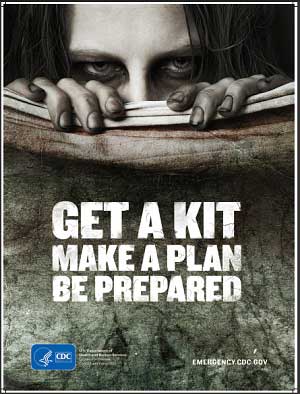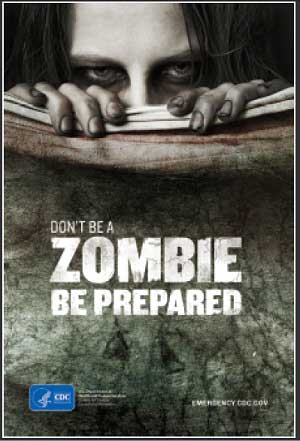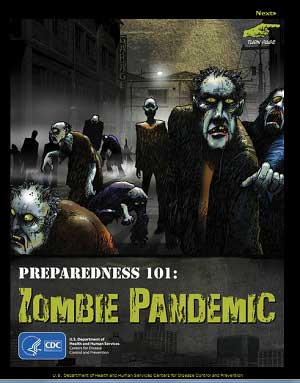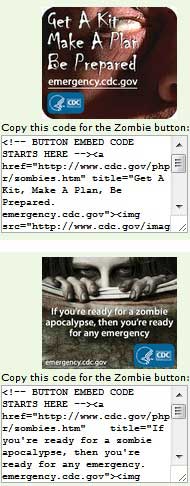Recently, a video prank of a "zombie attack" went viral online. If only the "victim" in the video had read the Center for Disease Control's Preparedness 101: Zombie Apocalypse guide.
No, the CDC doesn't believe in zombies, but the CDC does believe in disaster preparedness.
To inspire people to prepare emergency kits for real-life disasters, the CDC brilliantly crafted the imaginative (and educational) zombie apocalypse campaign.
So how did the CDC generate more than 77,000 Facebook "Likes" and 2,357 tweets (as of the time this article was written) for its emergency guide? Here are eight takeaways for marketers.
1. Jump on the bandwagon
The CDC didn't create the buzz for its disaster-preparedness guide, but it did notice the growing interest in the AMC zombie television series "The Walking Dead." Wielding its imagination, sense of humor, and marketing smarts, the CDC assembled a disaster-preparedness guide with the zombie trend in mind. And now that terms such as "zombie apocalypse" are trending online, the guide has come to be in demand once more.
Savvy marketers should also listen to online conversations and notice what trends seem to be capturing the public's imagination. Does your business have the flexibility and imagination to create or reimagine content to suit the public's demand for such topics?
2. Keep the tone consistent throughout your content
Straightforward, button-down writing works well for no-nonsense content pieces. But folks who read a zombie apocalypse guide expect something a little different, and the CDC delivered.
The guide begins with a tongue-in-cheek warning and a blunt description of its mission: "There are all kinds of emergencies out there that we can prepare for. Take a zombie apocalypse for example. That's right, I said z-o-m-b-i-e a-p-o-c-a-l-y-p-s-e. You may laugh now, but when it happens you'll be happy you read this, and hey, maybe you'll even learn a thing or two about how to prepare for a real emergency."
That informal writing style that combines humor and purposefulness continues throughout the guide. For example, rather than rattle off a boring list of items to stock, the CDC adds dashes of dark humor to its list: "First Aid supplies (although you're a goner if a zombie bites you, you can use these supplies to treat basic cuts and lacerations that you might get during a tornado or hurricane)."
Marketers should consider the tone of each content piece they create. Do the style and tone of the writing enhance your marketing message—or detract from it?
3. Provide visual content to get your point across
Rather than relying solely on text for its zombie campaign, the CDC created different forms of visual content to enhance the campaign. The CDC's zombie guide is packed with visuals, such as posters, blog and website badges, a graphic novella, and video clips from "The Walking Dead" television program.
Marketers should consider how they can create visual content that enhances their written content. Can you take an idea and craft a Pinterest-worthy image from it? Can you make it easy for readers to share an image? Think beyond text.
4. Give your audience something to take offline
The CDC offers downloadable zombie preparedness posters. Each poster (downloadable PDFs) concisely addresses the main focus of the zombie campaign—encouraging folks to prepare emergency kits—but the posters do so with deadpan humor, in the same style as the guide.


Moreover, the CDC site features a free graphic novella, titled Zombie Pandemic.

The CDC makes sure readers know the purpose behind the free zombie novel by including the following descriptive text: "Readers follow Todd, Julie, and their dog Max as a strange new disease begins spreading, turning ordinary people into zombies. Stick around to the end for a surprising twist that will drive home the importance of being prepared for any emergency."
To reinforce the overall message of the novel, the PDF version (which consists of the novella "script") includes a preparedness checklist.
5. Enable social sharing of your content
The terms "zombies" and "zombie apocalypse" have infested Twitter, YouTube, and other social networks like, well, zombies.
To help readers easily share the guide's contents via social networks, the CDC created badges and widgets. Readers can copy and paste HTML code onto their blogs or websites. Matching the zombie apocalypse guide's look, the badges and widgets have a gritty, creepy feel to them... while spreading the same message of the need for preparedness.

6. Inspire user-generated content
Too often, companies approve of content only they themselves have created. However, if your brand or company inspires people to create content, encourage folks to share it with your company (and maybe even offer them fabulous prizes for doing so).
For example, the CDC asks its blog readers, "Have you begun preparing for a zombie apocalypse? Tell us about what you are doing to prepare!" And then the CDC offers a link to a video contest.
7. Provide extra-special content for ardent admirers
Videos? Check. Website badges? Check. Novella? Check. But what about folks who are willing to pay for a little something extra?
The CDC's nonprofit foundation created a zombie task force T-shirt for folks to proudly proclaim that they will survive the zombie apocalypse. And how successful was that decision? The T-shirts have sold out.
8. Be prepared to shift gears
The CDC produced the zombie guide in 2011—long before 2012's outbreak of horrific crimes that seemed straight out of zombie films. Had the CDC produced and marketed such a guide during mid-2012, the move would have been considered bad form.
Companies should have a backup plan in case a marketing campaign goes horribly wrong—or in case current events render the campaign suddenly distasteful. If the CDC had not published the zombie guide before the outbreak of those crimes, it would have had to decide whether to risk having its dark humor seen as disrespectful or to launch Plan B (if it had one).
* * *
Whether a zombie apocalypse is likely or not (let's go with "not"), getting your message across clearly is always important. Create content that not only captures your audience's attention and imagination but also stays focused.
And be prepared.




